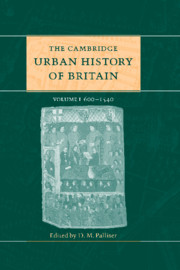Book contents
- Frontmatter
- Part I Introductory
- Part II The early middle ages 600–1300
- Part III The later middle ages 1300–1540
- Part IV Regional surveys
- 21 Regional introduction (England and Wales)
- 22(a) The South-East of England
- (b) The South-West of England
- (c) The Midlands
- (d) East Anglia
- (e) Northern towns
- (f) Wales and the Marches
- 23 Scotland
- Part V Conclusion
- Appendix: Ranking lists of English medieval towns
- Select bibliography
- Index
- References
(f) - Wales and the Marches
from 22(a) - The South-East of England
Published online by Cambridge University Press: 28 March 2008
- Frontmatter
- Part I Introductory
- Part II The early middle ages 600–1300
- Part III The later middle ages 1300–1540
- Part IV Regional surveys
- 21 Regional introduction (England and Wales)
- 22(a) The South-East of England
- (b) The South-West of England
- (c) The Midlands
- (d) East Anglia
- (e) Northern towns
- (f) Wales and the Marches
- 23 Scotland
- Part V Conclusion
- Appendix: Ranking lists of English medieval towns
- Select bibliography
- Index
- References
Summary
a framework
In 1300 Wales was almost as urbanised a country as England (Map 22.12). The current view, based largely, if tentatively, on the surviving records of a lay subsidy imposed on Wales by Edward I in 1292–3, is that Wales' population at that time was about 300,000 souls. It had about 100 towns and chartered boroughs, albeit they were on average smaller in size than those of England; only a minority is likely to have had more than 1,000 inhabitants each. The proportion of Wales' population that lived in these towns seems not to have been significantly smaller than town-dwelling proportions in England (estimated at 15 per cent) or Spain; fewer than one fifth of these town dwellers were of Welsh descent. Furthermore, in 1300 townsmen and country dwellers from Wales were regular visitors to the substantial, prosperous border towns of Chester, Oswestry, Shrewsbury, Ludlow, Leominster, Hereford, Tewkesbury, Gloucester and, by sea and ferry, to Bristol, whose own merchants customarily plied their trades in many a Welsh town.
Wales in 1300, then, was an urbanised society to a significant degree. This may seem surprising in view of the fact that Gerald of Wales (c. 1146–1223), who knew southern Wales especially well and had travelled widely through much of the country, implied that the Welsh population: do not live in towns, villages or castles, but lead a solitary existence, deep in the woods. It is not their habit to build great palaces, or vast and towering structures of stone and cement. Instead they content themselves with wattled huts on the edges of the forest, put up with little labour or expense, but strong enough to last a year or so.
- Type
- Chapter
- Information
- The Cambridge Urban History of Britain , pp. 681 - 714Publisher: Cambridge University PressPrint publication year: 2000
References
- 1
- Cited by



